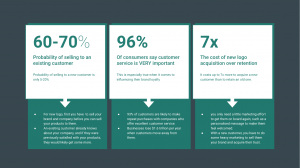Oh, how we love our ABCs! We’re talking about the ABCs is sales, of course – “Always Be Closing,” as Alec Baldwin’s character puts it in Glengarry Glen Ross.
The motivational slogan is great, and yes, sales and revenue are crucial for every company out there in the SaaS industry. However, if you’ve been in the game long enough, you know that no amount of growth can save you if you’re not retaining the users that sign up.
After all, it cost 7 times as much to attract a new customer as opposed to retaining an existing one. It is also easier to sell to existing clients. According to MarkinBlog’s customer retention statistics, the probability of selling to an existing client lingers around 65%. The probability of selling to a new customer, however, is only 5-20%.

When we lose customers, we can’t rely on them to tell us what’s wrong. Even though 50% of the customer base will churn naturally over 5 years, only 4% of unhappy customers will voice their complaints. That leaves 96% of departing customers leaving without letting you know why.
Rude? Yes. Fair? Also yes. Companies must earn customer loyalty, which leads to customer retention. So If you want to grow sustainably, build a better product, and have happier customers, retention is a key piece of your SaaS puzzle. To facilitate it, it’s important to understand customer retention analytics. Why are they important? What types of analytics are there? Which metrics are the most essential?
We’re here to answer all those questions.
Why are customer retention analytics important?
First and foremost, if you follow and understand your retention analytics, it will be easier to retain your customers. You won’t have to focus on stopping the bleeding. Every new customer that you get will be there to stay instead of churning after a few months.
You can grow sustainably. If you can’t hold on to your customers, you can’t plan your growth. Once you know what to address, you will have an easier time getting more customers. It will be easier to upsell to your existing customers. Even if the customers you hold on to are not on your paid plans, by retaining them you have better access to them. That, in the future, leaves the option of upselling to them open. On the other hand, if that customer leaves, there is no such option.

The types of customer retention analytics
Depending on your goals, there are a total of five types of retention analytics: descriptive, diagnostic, prescriptive, and predictive analytics. Let’s see how they differ.
Descriptive analytics looks at data to tell you what happened in the past. This means that you can look back on a certain period of time and interpret data by providing context through graphs, charts, reports and dashboards. It may be time-consuming, but it can help you distinguish patterns you can investigate in detail.
Diagnostic analytics take descriptive data a step further to really get to the cause of the problem. Just like the name says, diagnostic analytics are trying to figure out why something happened.
Predictive analytics takes previous data and feeds it into an AI and machine learning model that predicts trends and patterns.
Prescriptive analytics takes predictive data and tells you what to do next. This type of analytics is best used in situations when you have a specific question and more than one possible solution. It outlines potential implications so that you can have all the necessary facts when making the final decision.
Outcome analytics provide insight into customer behavior (how they use your products and services) that drives specific outcomes. It’s common to find these types of analytics in software products and online course platforms. Understanding customers’ behaviors is essential, so this type of information is the goal of customer retention analytics. Creating a customer journey map is a great way to package outcome analytics in a comprehensive plan.
The best ways to retain your customers
Data is great. But it means nothing if you don’t put it to use. There are different ways to improve retention using customer retention analytics. Here are some of the ways we tried out on our own.
1. Get committed to analyzing your data
You can’t manage what you don’t measure. If you do not have proper analytical tools then the first thing you need to do is take a step back and implement product analytics. A lot of times, companies lose customers without paying attention that it’s happening and what the causes are. Grab some great analytics software and pay attention to the trends happening with your mobile user acquisition and churn.
Jon Torres of JonTorres says, “Having a deep understanding of your analytics makes you a better marketer. You’re simply wasting time and money if you’re not tracking the key performance indicators or KPIs that are important to your business. Knowing your data helps you catch issues quickly and spend money more effectively.”
2. Focus only on a certain type of customer
Although every customer is important, losing an enterprise customer with 100 seats and a freelancer with just one paid plan is not the same. Take a deep dive into your customer data to find out who is churning and why. Focus only on those customers that bring in revenue and whose business pushes the needle.
We sell to a wide range of businesses. Some are more likely to stay with us, while others (like freelancers) are a more fickle audience and churn pretty quickly. In order to reduce churn, you will need to align your marketing strategy and acquisition channels with your buyer persona.
Meaning, you need to analyze your sources and find out which ones are getting you the most quality business and focus on them. That way you will get more targeted leads and the chances that they will retain are higher. Know the people you sell to and when you generate leads, focus on the type of audience that won’t leave quickly after signup.
3. Segment your audiences
Not all of your customers are alike. We figured out that some people stick around for longer and spend more. Other customers are more seasonal. You’ll never know if you treat all of your customers the same.
Segmenting people into different groups gives you the opportunity to identify how each segment responds to your brand messaging. And this way, you can draw insight for each group you created and make plans on how to increase retention for your most wanted customer group.
Analyze their demographics (age, location, education, job, etc.), lifestyle and purchase value. The more insights you can get, the clearer the future actions will be. Once you find the segmented group that spends the most, focus on them, and slowly spread to the other closer groups.
Conclusion
No matter what type of business you run, it’s crucial that you track how your customers are behaving and why they are leaving you. This way, you will not only retain customers that are on the fence but also build a stronger relationship with your loyal customers. It’s the only way to grow your business without bleeding money.




